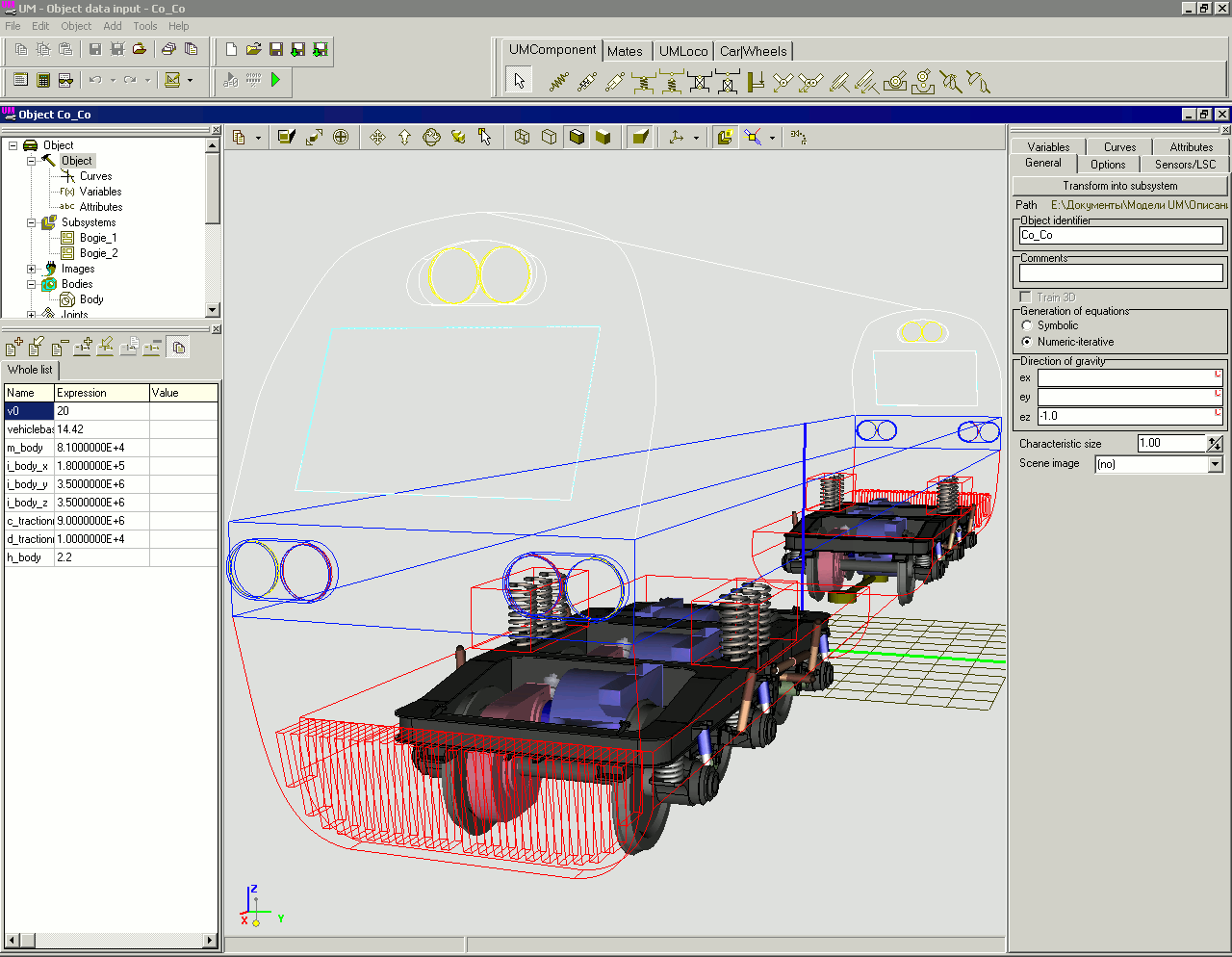UM Subsystems
UM Subsystem -
The subsystem module -
Features of the module
The subsystem module
The subsystem technique is a basis of modeling objects with large number of degrees of freedom and creation of databases of typical design elements for modeling technical systems. By using this method an object is represented as a tree of subsystems, which are linked by means of force elements and constraints. Any object previously created by the user can be loaded as a subsystem. An object may include any number/tree of subsystems.
Let,s consider a diesel locomotive model, which consists of a car body and two bogies. Every bogie contains a frame and three wheelset/motor assemblies. The wheel/motor assembly consists of a wheelset and a traction engine. The user creates the subsystem - "Wheelset/motor assembly", which includes the wheelset and the engine along with all force elements (external elements). These elements link the subsystem with the bogie frame. Then the user describes subsystem - "Bogie", which includes three "Wheelset/motor assembly" subsystems as well as the frame and force elements connecting the frame and the car body. The diesel locomotive model contains one body - car and two subsystems - bogies. There exists a three-level tree of subsystems in this exampleOther example: the technique could be used in the railway vehicle dynamics to model a train, which consists of a locomotive and several uniform cars. It is enough to describe the models of the locomotive and just one car. Then the user can include any number of cars in the model of the train.
Any object created in UM can be a subsystem. To establish connections and force interactions between subsystems it is sufficient to describe some force elements and joints as external.
The subsystem technique gives the user a comfortable interface for work with identifiers. Since identifiers of different subsystems can have various values then subsystems can model similar elements but with different parameters. For example a fully parameterized model of a freight wagon with three-piece bogies can be used for the analysis of dynamics of an open wagon, a hopper, a tank truck etc., for both empty and loaded modes, in nominal and off-nominal states (for example due to wear). The user can describe any configuration of a train by including given subsystem in a train model so many times as it is necessary and changing values of identifiers in separate subsystems.
The subsystem technique is a basis for developing specialized UM modules by means of creation of standard subsystems. For example the standard subsystem - "Wheelset" is a basis for the simulation of railway vehicles. The simulation of tracked vehicles is connected with the standard subsystem - "Caterpillar", where the most complex operations of the synthesis of subsystem elements are made automatically: the user sets the number of track rollers, their positions and parameters, the type of suspension (for example torsions), the number of tracks, and other parameters, while the subsystems with the mentioned parameters will be dynamically generated. The tire/road contact model along with the set of standard subsystems, which are car typical suspensions (double wishbone suspension, MacPherson suspension etc.) are the main components for modeling car dynamics. Since the subsystems are fully parametrized and opened for modification it is simple to take into account particular features of a designed car. Of course the user can add subsystems for his own models and create databases of typical design elements.


Features of the module:
- simplicity of model modification by means of change of certain subsystems by using preliminary created databases;- possibility to set different values to parameters of different subsystems derived from common parent;
- possibility to create hybrid objects, which include rigid and flexible bodies;
- possibility to simulate mechanical systems with large number of degrees of freedom;
- possibility to synthesize equations of motion for a separate subsystem in advance.
- simplicity of creation of complex technical system models especially when the models contains multiple typical design elements;




